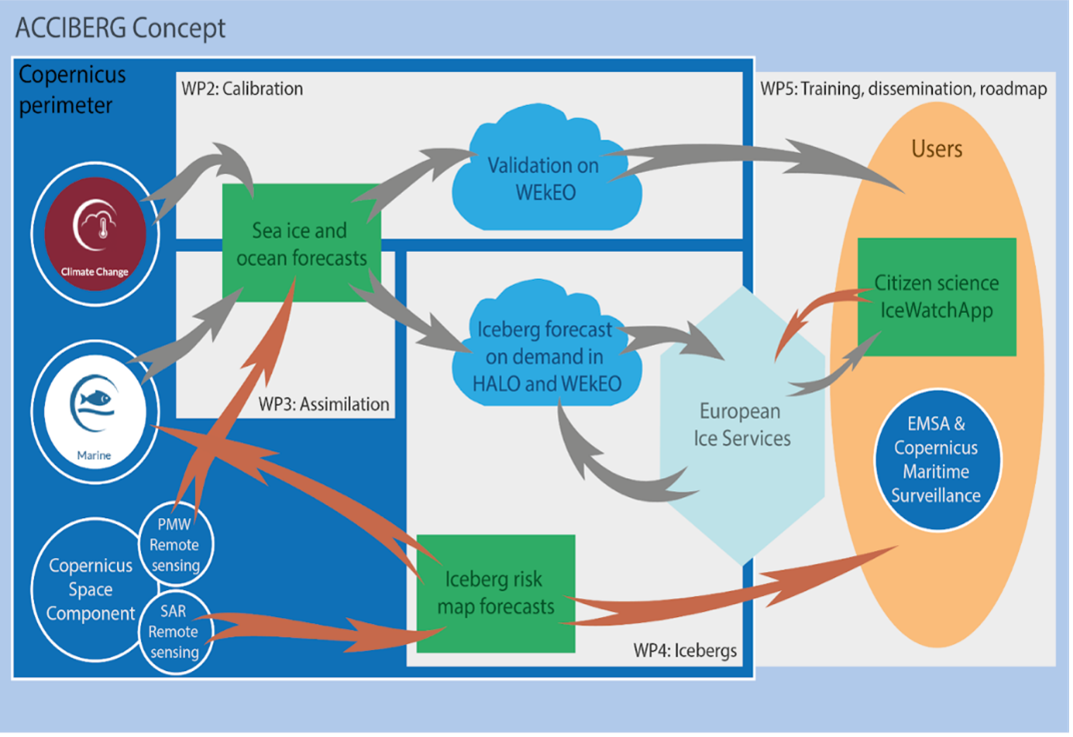Arctic Cross-Copernicus forecast products for sea ice and iceBERGs (ACCIBERG)
Contrary to sea-ice state and forecasts, there is little information about icebergs available publicly except for the area around Newfoundland, Labrador Sea and the southern tip of Greenland. Even in these areas the mariners need improved iceberg detection and forecasts for safe transit and better route guidance on time scales ranging from hours to several days. Voyage planning usually starts months ahead by the selection of ship, season, and crew.
Today, this planning step lacks information about expected iceberg density, and environmental parameters such as sea ice, and is thus still relying on past typical conditions.
Monitoring and forecasting icebergs ahead of time is dependent on adequate forecasts of sea ice, ocean, wind, and wave conditions for the whole Arctic, which are part of the Copernicus Marine and Climate Change Services. However, the uncertainties on these parameters can be large, unavailable and/or inconsistent between Copernicus services in the Arctic. Assimilation of satellite observations can reduce these uncertainties, and forecast ensembles can provide reliable uncertainty estimates. But for sea ice, this is currently not being done consistently across Copernicus.
The ACCIBERG project plans to tackle all the above problems by improving the forecasts of the necessary sea ice and ocean parameters and their uncertainties in both Copernicus Marine and Climate Change Services, extending the coverage of the satellite detection of icebergs and developing a new iceberg forecast service.

Objectives/Mission
Objective 1: ACCIBERG plans to demonstrate two prototypes of iceberg forecasts, freely available, one as density maps showing risky areas and one as individual iceberg trajectories computed on-demand, both based on Copernicus data. The forecasts will incorporate new algorithms for detecting icebergs beyond Greenland waters. ACCIBERG targets primarily the short-term (days) trajectories for ship assistance but also longer trajectories of larger icebergs that can drift for months or longer. This motivates the need for a cross-Copernicus forecasting system, capable of selecting the most adequate input to drive the iceberg trajectories: the winds, ocean currents, sea ice cover and drift, and the ocean waves. Three of the participating partners have previous experience with iceberg simulations, so the aim is to run the simulations in the environment of the operational entity and demonstrations with targeted users. The target accuracy of the 5-days forecast is 30 km of location error.
Objective 2: to improve the assimilation of sea ice parameters in operational ocean and sea-ice forecasting models for providing safe navigation. Up to now, only high-level and heavily processed satellite data products (Level-3 and Level-4) have been assimilated in the sea-ice forecast models. In ACCIBERG we want to introduce the assimilation of raw (Level-1) satellite data for improving the forecasts of sea-ice concentration and sea-ice type. Proof of concepts of such Level-1 assimilation exist today that use satellite simulators to link the model variables to the raw satellite observations. They. however, lack calibration with the satellite data and are not integrated in the forecast systems of Copernicus. In ACCIBERG we will develop dynamic sea-ice calibration of the satellite simulators and integrate them in the data assimilation system of the Arctic CMEMS forecast system, which will make it easy to integrate the developments in the existing service. We will demonstrate a cost-effective assimilation of existing satellites with improved sea-ice forecasting skills. Beyond the timeframe of the project, our developments prepare for the optimal use of the future CIMR satellite mission, one of the planned Copernicus Expansion missions.
Objective 3: to provide calibrated sea-ice forecast products for days to seasons ahead together with reliable uncertainty estimates, bringing together data from the Copernicus Marine Environment Monitoring and Climate Change Services. This will build on existing proof of concepts for the validation and calibration of probabilistic sea-ice forecasts that rely on ensemble and retrospective forecasts. Prototypes of forecast products will first be developed and finally implemented and tested on a cross-Copernicus WEkEO platform. Potential end users will be involved to make sure these products are relevant to them. The WEkEO platform will provide a convenient single point of entry service for the end users: They can obtain sea-ice information for the next days, weeks or season ahead. The new methods and tools for validation and calibration of probabilistic sea-ice forecasts will also support the research-to-operations process for marine ensemble forecasting systems across the Copernicus Services. In particular, developments of ensemble forecasting with a major new sea-ice model and stochastic perturbations of sea-ice dynamics and thermodynamics will be tested to make recommendations for future improvements to the monitoring and forecasting systems underpinning the Copernicus Services.
Website:
Social Media:
![]() @acciberg
@acciberg
Contacts:
 NERSC Project Coordinator
|  NERSC Project Manager
|
